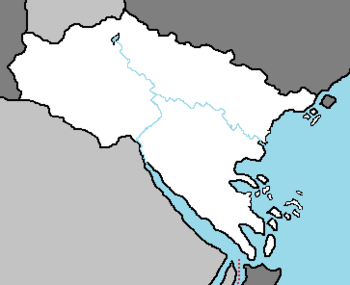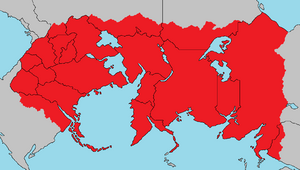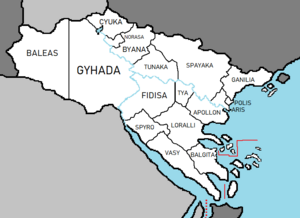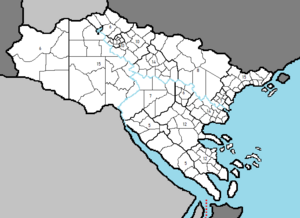Constantio: Difference between revisions
No edit summary |
|||
| Line 226: | Line 226: | ||
==Economy== | ==Economy== | ||
Constantio is a developed country with a high standard of living and a high ranking in the Human Development Index. The GDP is measured at 402.6 billion annually. Its economy mainly comprises the service sector (85.0%) and industry (12.0%), while agriculture makes up 3.0% of the national economic output. Important Constantioan industries include tourism (with 14.9 million international tourists in 2019, it is ranked as one of the most visited countries in the world and [[Nortua]]) and merchant shipping (at 6.2% of the world's total capacity, the Constantioan merchant marine is among largest in the world), while the country is also a considerable agricultural producer (including fisheries). | |||
===Agriculture=== | |||
In 2010, Constantio was one of the world's largest producer of cotton (183,800 tons) and pistachios (8,000 tons) and ranked second in the production of rice (229,500 tons) and olives (147,500 tons) on the continent of [[Nortua]], third in the production of figs (11,000 tons), almonds (44,000 tons), tomatoes (1,400,000 tons), and watermelons (578,400 tons) and fourth in the production of tobacco (22,000 tons). Agriculture contributes 3.8% of the country's GDP and employs 12.4% of the country's labor force. | |||
===Energy=== | |||
===Maritime industry=== | |||
[[File:Greek_tanker_ship.png|thumb|left|Constantio companies own over 6.5% of the world's merchant fleet]] | |||
The shipping industry has been a key element of Constantio economic activity since ancient times. Shipping remains one of the country's most important industries, accounting for 4.5 percent of GDP, employing about 160,000 people (4 percent of the workforce), and representing a third of the trade deficit. The Constantio Merchant Navy is the fourth largest in the world at 6.2 percent of total global capacity, up from 5.96 percent in 2010, but below the peak of 8.2 percent in 2006. The country's merchant fleet ranks third in total tonnage (122 million dwt), fourth in total number of ships (at 3,150), first in both tankers and dry bulk carriers, fourth in the number of containers, and fifth in other ships. However, today's fleet roster is smaller than an all-time high of 5,000 ships in the late 1970s. Additionally, the total number of ships flying a Constantio flag (includes non-Constantio fleets) is over 1,500, or 5.3 percent of the world's deadweight tonnage. | |||
During the 1960s, the size of the Constantio fleet nearly doubled, primarily through the investment undertaken by the shipping magnate [[Benson Schroder]]. The basis of the modern Constantio maritime industry was formed after the [[World War (Iearth)|World War]] when Constantio shipping businessmen were able to amass surplus ships sold to them by the [[Zamastan]]ian and [[Besmenia]]n governments. Constantio has a significant shipbuilding and ship maintenance industry. The six shipyards around the port of [[Balgita]] are among the largest in Nortua. In recent years, Constantio has also become a leader in the construction and maintenance of luxury yachts. | |||
===Tourism=== | |||
{{Template:Coalition of Crown Albatross}} | {{Template:Coalition of Crown Albatross}} | ||
[[Category:Countries]][[Category:Coalition of Crown Albatross]] | [[Category:Countries]][[Category:Coalition of Crown Albatross]] | ||
[[Category:Constantio]] | [[Category:Constantio]] | ||
Revision as of 01:51, 21 August 2021
Republic of Constantio | |
|---|---|
|
Flag | |
 Constantio | |
| Capital | Constantinopolis |
| Largest city | Norasa |
| Demonym(s) | Constantioan |
| Government | Federal presidential constitutional republic |
| Tony Blanian | |
| Macie Shepard | |
| Toby Kennedy | |
| Establishment | |
• Empire | 1591 |
• Republic | 1 April 1846 |
• Last constitutional amendment | 8 August 2012 |
| Area | |
• | 423,967 km2 (163,695 sq mi) |
| Population | |
• 2020 estimate | 26,889,000 |
• Density | 63.42/km2 (164.3/sq mi) |
| GDP (PPP) | 2021 estimate |
• Total | 402.638 billion |
• Per capita | 16,872 |
| Gini | 41.2 medium |
| HDI | 0.888 very high |
| Currency | Norta |
| Date format | mm-dd-yyyy |
The Republic of Constantio, most commonly known as Constantio, is a nation in the Coalition of Crown Albatross located on the continent of Nortua, bordered by Birnir, Cechena, Syraranto, and a maritime border with Karabakhi. Constantio's location and prominent political influence in the Sotoa Sea region makes it a middle power, often competing with neighboring Syraranto for dominance in the region. Constantio's jagged coast line on the Sotoa Sea, the second longest on the body of water after Syraranto, is dotted with rocky islands and shallow reefs, making it a hotspot for bidiversity. Inland mountains and rolling hills dominate the mainland geographical buildup.
With a rich history extending back tens of thousands of years with early human civilization, Constantio rose to prominence with the foundation of the Constantio Empire in 1591 with the conquest of neighboring Cechena. As the empire grew, it expanded to become one of the largest in the history of the world, encompassing nearly a third of the continent of Nortua, with a range from northeastern Birnir to central Besmenia. The empire collapsed at the conclusion of the Chezian Wars of Independence (1806-23), and became a republic in the mid 1800s.
The nation is known for extensive civil rights and political freedoms, though recent years have seen rampant corruption scandals. Constantio was one of the nations involved in the extensive and bloody Chezian War (1992-95), which left tens of thousands dead in the effected areas of the country. It is considered a middle power, and is a member state of several international organizations such as the Coalition of Crown Albatross, the Coalition Trade Organization, and the Sotoan Basin Union. Its population of 26.9 million is largely urbanized, with the capital of Constantinopolis and the cities of Norasa and Balgita accounting for nearly a half of the country's total population. Its economy is well developed thanks to international cooperation and investment, with a GDP around 402.638 billion and a per capita GDP of 16,872.
History
Prehistory
Antiquity
Constantio Empire
Founding
Expansion
Decline
Modern Era
Republic
Geography

Located in Western Nortua, Constantio is bordered to the west by Birnir and Cechena, to the northeast by Syraranto, and to the south by the Sotoa Sea and the maritime border with the Karabakhi Archipelago. The highest point is Mount Torabe at 2,764 m (9,068.24 ft) in the westernmost corner of the country along the border with Cechena; the lowest point is the Sotoa Sea at 0 m (0.00 ft). Eighty percent of Constantio consists of mountains or hills, making the country one of the most mountainous in Nortua. Western Constantio contains a number of lakes and wetlands and is dominated by the Birnir Mountains and the Chezian Mountains.
Due to its highly indented coastline and numerous islands, the nation has an extensive coastline. It is dotted with rocky islands and shallow reefs, making it a hotspot for bidiversity. Patches of plain regions are primarily located in the northern regions. They constitute key economic regions as they are among the few arable places in the country. Rare marine species such as the pinniped seals and the loggerhead sea turtle live in the seas surrounding mainland Constantio, while its dense forests are home to the endangered brown bear, the Nortuan lynx, the roe deer and the wild goat.
The climate of Constantio is primarily dry summer climate, featuring mild, wet winters and hot, dry summers. This climate occurs at all coastal locations, including Balgita. The Chezian mountain range strongly affects the climate of the country, as areas to the west of the range are considerably wetter on average (due to greater exposure to south-westerly systems bringing in moisture) than the areas lying to the east of the range (due to a rain shadow effect).
The mountainous areas of Northwestern Constantio feature an Alpine climate with heavy snowfalls. The inland parts of northern Constantio feature a temperate climate with cold, damp winters and hot, dry summers with frequent thunderstorms. Snowfalls occur every year in the mountains and northern areas, and brief snowfalls are not unknown even in low-lying southern areas near the coast.
Politics
The Republic of Constantio is a federal republic of 16 provinces and a federal district. It is a federal republic and a representative democracy. The nation's politics operate under a framework laid out in the constitution wherein the President of Constantio functions as the head of state and the Vice President and the 152-seat Assembly of Constantio operate jointly as the head of government. The government is based on the separation and balancing of powers among the legislative (Assembly of Constantio), judiciary (Supreme Court of Constantio) and executive (President). The executive power is exercised by the president. The president is the commander-in-chief of the military and the representative of the unity of the Constantioan people. Presidential elections and Assembly elections occur at the same time every three years, with the most recent election having been held on August 21st, 2021.
The capital is located in Constantinopolis, which serves as a federal district.
Political Parties
Upon the foundation of the Republic on April 1st, 1846, the dominant party in Constantio was the liberal-conservative New Democracy (ND) and the social-democratic Constantio Socialist Movement (CSM). In the 21st century, other parties have gained prominence such as the Progressive Party, the Green Party
Administrative Divisions
Constantio is divided into 16 provinces and one federal district which constitutes the capital of Constantinopolis.
| Province | Capital | Governor | MP Seats |
|---|---|---|---|
| Baleas | Iliougara | Ashton Stanton | 6 |
| Gyhada | Darina | Leo Lowe | 15 |
| Norasa | Norasa | Holden Anthony | 10 |
| Cyuka | Alifplio | Eddie Christensen | 6 |
| Byana | Trapapolis | Jaeden Gill | 10 |
| Tunaka | Tunaka | Daniel Harris | 14 |
| Spayaka | Cesegliari | Jeffrey Shelton | 8 |
| Ganilia | Pocia | Sean Mcdonald | 15 |
| Aris | Missokastro | Chandler Thompson | 7 |
| Appolon | Tarralusia | Patrick Murray | 14 |
| Loralli | Gremno | Keaton Aguirre | 12 |
| Balgita | Balgita | Oliver Harrison | 12 |
| Vasy | Caltaci | Finlay Moss | 5 |
| Spyro | Kozakas | Kayden Adams | 5 |
| Tya | Folina | Caden Simon | 6 |
| Fidisa | Zamanca | Giovanni Petersen | 7 |
Military
The Constantio Armed Forces are overseen with civilian authority vested in the Defense Ministry of Constantio. It consists of three branches:
Constantio military personnel total 364,050, of whom 142,700 are active and 221,350 are reserve. Mandatory military service, abolished in 2014, was nine months for the Army and one year for the Navy and Air Force. Additionally, Constantio males between the ages of 18 and 60 who live in strategically sensitive areas may be required to serve part-time in the National Guard.
Foreign Relations
Foreign relations in Constantio are constituted through the Foreign Ministry of Constantio, and its head, the Foreign Affairs Minister, currently Toby Kennedy. Officially, the main aims of the Ministry are to represent Constantio before other states and international organizations; safeguard the interests of the Constantio state and of its citizens abroad; promote Constantio culture; and encourage international cooperation.
Constantio is a member of the Coalition of Crown Albatross, the Coalition Trade Organization, the Sotoa Basin Union, and other organizations centered around international cooperation. Constantio hosts more than 80 embassies within the capital and other cities like Norosa and Balgita, and has more than 70 consulates and embassies overseas. Its closest ally is generally considered to be Vuswistan, with other key allies including Utobania, Siniapore, and Besmenia.
Demographics
Language
Religion
Cities
See also: Cities in Constantio
|
Metropolitan areas in Constantio | |||||
| No. | CMA City |
Population | |||
| 1 | Norasa | 4,349,000 | |||
| 2 | Constantinopolis | 1,233,000 | |||
| 3 | Balgita | 1,023,000 | |||
Culture
Economy
Constantio is a developed country with a high standard of living and a high ranking in the Human Development Index. The GDP is measured at 402.6 billion annually. Its economy mainly comprises the service sector (85.0%) and industry (12.0%), while agriculture makes up 3.0% of the national economic output. Important Constantioan industries include tourism (with 14.9 million international tourists in 2019, it is ranked as one of the most visited countries in the world and Nortua) and merchant shipping (at 6.2% of the world's total capacity, the Constantioan merchant marine is among largest in the world), while the country is also a considerable agricultural producer (including fisheries).
Agriculture
In 2010, Constantio was one of the world's largest producer of cotton (183,800 tons) and pistachios (8,000 tons) and ranked second in the production of rice (229,500 tons) and olives (147,500 tons) on the continent of Nortua, third in the production of figs (11,000 tons), almonds (44,000 tons), tomatoes (1,400,000 tons), and watermelons (578,400 tons) and fourth in the production of tobacco (22,000 tons). Agriculture contributes 3.8% of the country's GDP and employs 12.4% of the country's labor force.
Energy
Maritime industry
The shipping industry has been a key element of Constantio economic activity since ancient times. Shipping remains one of the country's most important industries, accounting for 4.5 percent of GDP, employing about 160,000 people (4 percent of the workforce), and representing a third of the trade deficit. The Constantio Merchant Navy is the fourth largest in the world at 6.2 percent of total global capacity, up from 5.96 percent in 2010, but below the peak of 8.2 percent in 2006. The country's merchant fleet ranks third in total tonnage (122 million dwt), fourth in total number of ships (at 3,150), first in both tankers and dry bulk carriers, fourth in the number of containers, and fifth in other ships. However, today's fleet roster is smaller than an all-time high of 5,000 ships in the late 1970s. Additionally, the total number of ships flying a Constantio flag (includes non-Constantio fleets) is over 1,500, or 5.3 percent of the world's deadweight tonnage.
During the 1960s, the size of the Constantio fleet nearly doubled, primarily through the investment undertaken by the shipping magnate Benson Schroder. The basis of the modern Constantio maritime industry was formed after the World War when Constantio shipping businessmen were able to amass surplus ships sold to them by the Zamastanian and Besmenian governments. Constantio has a significant shipbuilding and ship maintenance industry. The six shipyards around the port of Balgita are among the largest in Nortua. In recent years, Constantio has also become a leader in the construction and maintenance of luxury yachts.








